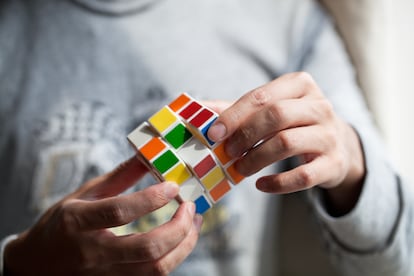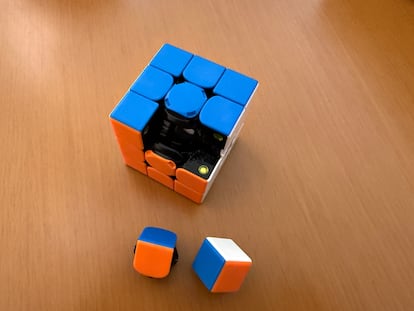50 years of the Rubik’s Cube: Can a tampered puzzle still be solved?
Group theory allows us to study this game invented in 1974, which has more than 43 trillion valid states and can be completed in 20 moves

In 1974, architecture professor Ernö Rubik invented a new tool to illustrate geometric concepts to his students at the Budapest School of Commercial Arts. Half a century later, the Rubik’s Cube has not only become one of the best-selling toys in history, but it has also inspired a global culture. Tournaments dedicated to the cube are held worldwide, countless design variations have been created, and it has even raised questions of interest to math researchers. For instance, if the cube is tampered — by peeling off stickers and rearranging them, or by disassembling and reassembling its pieces — can it still be solved?
The study of the Rubik’s Cube utilizes an area of mathematics known as group theory. This framework allows us to describe the cube’s movements in abstract terms and, for example, to show that the original cube can always be solved — i.e. each face can be made a single, unique color — in 20 moves or fewer, regardless of the initial arrangement. But what happens if the design is slightly modified?
To answer this question, we use the concept of a legal configuration, which refers to any state of the Rubik’s Cube that is solvable. All legal configurations can be achieved from the solved cube by concatenating movements that involve rotating one side of the cube by 90 degrees. Essentially, the configuration can be reversed by retracing the steps used to solve it. There are a total of 43,252,003,274,489,856,000 legal configurations, and each of these configurations is an element of a mathematical structure that we call a group.
From this perspective, the previous question becomes a matter of verifying whether allowing new moves, such as swapping the colors of the cube pieces, would create new configurations that fall outside the group of legal solutions. And if that were the case, determining if these new configurations could still be solved. In other words, could modifying the cube in this way create an unsolvable configuration? Or would it create another element of the group, a legal, solvable configuration?
For example, if you peel off all 54 stickers from the cube pieces and randomly stick them back on, could this transform a challenging puzzle into an impossible one? Experts in Rubik’s Cube will quickly recognize the answer: legal cube configurations always adhere to certain rules, and these rules would be easily violated by peeling off and reattaching stickers. In other words, non-legal — unsolvable — states can be created by this method.
Specifically, in legal configurations, the different types of cube pieces adhere to strict placement rules. These pieces fall into three categories: centers, edges, and corners. The edges are made up of pieces that each have exactly two different colors. There are also impossible combinations, since the opposite faces of the cube never share pieces.

In a classic Rubik’s Cube, the faces are arranged so that white is opposite yellow, green is opposite blue, and orange is opposite red. For instance, if the top face is white, then yellow must be on the bottom layer. This means that there can never be a white-yellow, green-blue, or orange-red edge, as the opposite faces can’t share pieces. Similarly, the corners follow a similar rule, and the centers of the cube must always maintain their original positions relative to each other, as they do not move with the face rotations.
Now, if we modify the cube by ensuring that the pieces’ colors still respect these opposite-face rules — effectively disassembling and reassembling the cube, rather than simply swapping stickers — the question arises: will this configuration always be solvable? The answer, however, is still negative. In fact, of all the possible modified configurations — which amount to a total of 519,024,039,293,878,272,000 possibilities — only one in 12 is solvable.
To perform this calculation, a concept from group theory called parity is used. Every move on the Rubik’s Cube, whether it’s the typical rotations or swapping pieces, can be seen as a permutation of the 20 movable pieces. Among these permutations, there is a special type called a transposition, which involves swapping just two pieces while leaving the rest unchanged.
A permutation is considered even if it requires an even number of transpositions to achieve it, and odd if it takes an odd number. The concept of parity is key in determining whether a configuration of the Rubik’s Cube is legal or not. By applying a simple criterion based on the parity of permutations (and some other fundamental principles), it is possible to assess whether a given configuration is legal or not.
By applying this parity criterion, it is possible to identify all the possible modifications of the Rubik’s Cube resulting from swapping pieces that are still solvable. This leads to the conclusion that 91.7% of tampered cubes, or cubes whose pieces have been swapped, can never be solved. The parity of permutations plays a crucial role not only in the Rubik’s Cube but also in other puzzles, such as the 15 puzzle, and in deeper mathematical questions, like solving algebraic equations.
Yago Antolín is a professor at the Complutense University of Madrid (UCM) and a member of the Institute of Mathematical Science (ICMAT)
Silvia Centenera has a degree in mathematics from the UCM.
Ágata Timón is the coordinator of the Mathematical Culture Unit of ICMAT.
Editing, translation and coordination: Ágata Timón García-Longoria. She is the coordinator of the ICMAT’s Mathematical Culture Unit.
Sign up for our weekly newsletter to get more English-language news coverage from EL PAÍS USA Edition
Tu suscripción se está usando en otro dispositivo
¿Quieres añadir otro usuario a tu suscripción?
Si continúas leyendo en este dispositivo, no se podrá leer en el otro.
FlechaTu suscripción se está usando en otro dispositivo y solo puedes acceder a EL PAÍS desde un dispositivo a la vez.
Si quieres compartir tu cuenta, cambia tu suscripción a la modalidad Premium, así podrás añadir otro usuario. Cada uno accederá con su propia cuenta de email, lo que os permitirá personalizar vuestra experiencia en EL PAÍS.
¿Tienes una suscripción de empresa? Accede aquí para contratar más cuentas.
En el caso de no saber quién está usando tu cuenta, te recomendamos cambiar tu contraseña aquí.
Si decides continuar compartiendo tu cuenta, este mensaje se mostrará en tu dispositivo y en el de la otra persona que está usando tu cuenta de forma indefinida, afectando a tu experiencia de lectura. Puedes consultar aquí los términos y condiciones de la suscripción digital.
More information
Archived In
Últimas noticias
The complicated life of Francesca Albanese: A rising figure in Italy but barred from every bank by Trump’s sanctions
Pinochet’s victims grapple with José Antonio Kast’s rise in Chile
Reinhard Genzel, Nobel laureate in physics: ‘One-minute videos will never give you the truth’
How Japan is trying to avert ‘digital defeat’
Most viewed
- Pablo Escobar’s hippos: A serious environmental problem, 40 years on
- Reinhard Genzel, Nobel laureate in physics: ‘One-minute videos will never give you the truth’
- Why we lost the habit of sleeping in two segments and how that changed our sense of time
- Charles Dubouloz, mountaineering star, retires at 36 with a farewell tour inspired by Walter Bonatti
- The Florida Keys tourist paradise is besieged by immigration agents: ‘We’ve never seen anything like this’










































